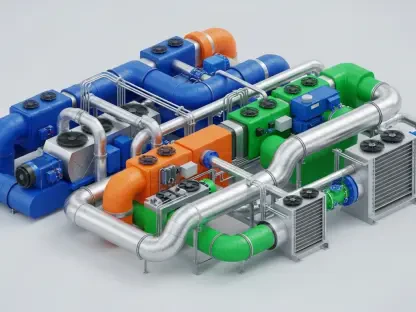The pharmaceutical industry today faces the dynamic challenge of balancing strict regulatory requirements with pressing financial constraints. Compliance has historically been the unwavering focus of pharmaceutical companies, ensuring not only adherence to government regulations but also maintaining public trust and avoiding hefty legal penalties. However, growing cost pressures have begun to vie for equal attention, forcing organizations to reevaluate budgets and strategic priorities. Significant events like large-scale layoffs and restructuring efforts among leading companies spotlight the urgency of this shift. To drive innovation and profitability, the industry must craft a finely tuned strategy that addresses the intricate interplay between compliance obligations and fiscal prudence.
The Shifting Landscape
Compliance as a Historical Priority
Compliance once stood as the cornerstone of pharmaceutical operations, the industry’s unwavering commitment evident in the substantial investments toward robust systems and processes. It is a realm largely defined by stringent regulatory frameworks varying across jurisdictions, demanding meticulous adherence to rules in manufacturing, distribution, and drug approval processes. For pharmaceutical companies, securing unwavering compliance has been more than just a mandate; it is a source of credibility and a shield against legal pitfalls. Nevertheless, these steadfast compliance mechanisms come at a significant cost, a burden that even the largest firms cannot ignore as they navigate today’s volatile economic environment.
These pressures have become more apparent in recent years, as companies strive to maintain their competitive edge without sacrificing the necessity of strict compliance. This has resulted in tough decisions such as workforce reductions and consolidation, with prominent players like Pfizer, ADC Therapeutics, and GSK making headlines for their cost-saving efforts. Such actions underscore the critical nature of the struggle and the lengths companies are willing to go to preserve financial health. The challenge lies in not only maintaining efficient compliance systems but evolving them with innovative approaches that minimize costs without compromising on regulatory adherence.
Cost-Cutting Emerges as a Competing Focus
Against the backdrop of compliance’s unyielding grip on industry operations, the push for cost reduction has emerged as a vigorous counterforce. In an era where profitability is paramount, organizations are examining every aspect of their operations with financial scrutiny, including the traditionally inviolable compliance budgets. The imperative to trim costs is driven by factors such as patent expirations, market competition, and pricing pressures, all of which necessitate a more cautious approach to expenditure. It is a precarious balancing act with substantial implications for how companies allocate resources, take risks, and prioritize projects.
The pressure to streamline operational expenses manifests in various forms, from optimizing supply chains to outsourcing non-core functions, all while preserving the essence of compliance. The challenge is exacerbated by the relentless evolution of regulatory frameworks, which often demand rapid adaptation and continuous enhancement of compliance measures. Navigating this landscape requires a sophisticated understanding of both fiscal and regulatory dynamics, along with strategic foresight in managing potential risks and ensuring consistent compliance.
Embracing Technological Solutions
The Role of AI and Automation
Technology stands as a beacon of hope for pharmaceutical companies grappling with the dual imperatives of compliance and cost-efficiency. Amid escalating demands, artificial intelligence and automation offer pathways to streamline operations while maintaining regulatory standards. Unlike in the past, where manual processes dominated compliance practices, today’s companies are expected to incorporate advanced technology that minimizes human error and enhances efficiency. By automating data management, audit trails, and monitoring systems, organizations can reduce manual workloads and allow employees to focus on strategic tasks, rather than routine compliance checks.
Yet, embracing these technologies is not without its challenges. There exists a cautious outlook among stakeholders who weigh the immediate costs of adopting sophisticated systems against their long-term benefits. The reluctance to make substantial upfront investments often hinders the integration of technology—an obstacle that companies must overcome to realize eventual savings. Moreover, ensuring security and reliability in automated processes remains critical, as any weaknesses can undermine compliance and risk exposure.
Global Compliance Systems
For companies spanning multiple regions, global compliance systems present an opportunity to centralize and standardize operations. These systems help manage regulatory variations and streamline data reporting across different markets, thereby facilitating smoother interactions and reduced administrative burdens. The investment in such systems is significant, demanding commitment not just in capital but also organizational alignment to extract their full value. It is an endeavor that redefines internal structures, processes, and incentives, necessitating a proactive approach to managing compliance.
However, while global systems offer a promising solution, the transition is complex. Companies need buy-in across various levels of operation, as change management becomes pivotal in navigating cultural and procedural differences. A successful implementation hinges on scalability, flexibility, and the ability to adapt to evolving enterprise needs, characteristics essential to handling the industry’s future challenges.
Maintaining Relationships with HCPs
The Importance of Human Contact
Amid sweeping technological advancements, maintaining personal relationships with healthcare providers (HCPs) remains a critical organizational focus. While automation can enhance operational efficiency and simplify administrative tasks, it risks diluting the quality of interaction that defines fruitful pharmaceutical relationships. HCPs, especially the younger demographic, value the ease and promptness automation brings, such as accelerated payment processes or streamlined communications. However, they also emphasize the richness of human interaction, which fosters trust and collaboration, critical aspects of pharmaceutical partnerships.
The challenge, thus, lies in integrating technology without overshadowing the human element deemed essential by stakeholders. Companies must strike a delicate balance that incorporates personalized interactions alongside streamlined processes. The solution unfolds as intuitive systems allowing engaging and meaningful exchanges, enriching rather than replacing human contact. Organizations are tasked with ensuring that automated communication complements rather than replaces the personalized touch integral to cultivating strong ties with HCPs.
Crafting Effective Communication Strategies
Pharmaceutical companies benefit greatly from effective communication strategies that emphasize meaningful and engaging interactions. This involves designing intuitive channels that ease connectivity and prioritize human engagement alongside automated processes. In crafting such strategies, companies are urged to consider the nuances of their audience—including preferences for communication methods and the value of personal relationships. Embracing technology must not leave behind the warmth and personal touch vital to building trust, understanding, and value-driven collaborations.
Achieving this balance also presents the opportunity to strengthen the pharmaceutical narrative as one driven by collaboration and shared goals rather than mere transactions. This means developing systems that ensure seamless integration between technological efficacy and relational rapport. By prioritizing both personalized interaction and efficient communication, companies can unlock relationships that yield both operational excellence and strong partnerships.
Strategic Outsourcing and Data Analytics
Outsourcing Compliance-Related Tasks
Outsourcing compliance tasks has emerged as a strategic response to mounting financial and regulatory pressures. By leveraging specialists for non-core activities, companies can allocate internal resources to initiatives that add value, drive innovation, and maximize efficiency. This approach allows organizations to unburden themselves from routine compliance operations that, while necessary, do not contribute directly to strategic goals. Specialized external partners equipped with industry expertise perform these duties efficiently, ensuring regulatory adherence without the high overhead costs associated with maintaining larger internal teams.
The strategic advantage of outsourcing lies in its ability to marry cost savings with compliance efficacy. It is a tactic that requires careful consideration of partner capabilities, industry reputation, and the ability to integrate seamlessly with existing processes. Notably, this practice provides companies with enhanced agility in responding to regulatory changes, freeing them to concentrate on strategic growth objectives.
Analytics-Driven Decision Making
Harnessing data analytics has become an essential component of modern compliance strategies. Real-time data analysis enables pharmaceutical companies to monitor compliance dynamically, anticipate risks, and address issues swiftly. By utilizing analytics-driven insights, companies can refine their decision-making processes, optimize operations, and stay ahead of potential pitfalls. This approach is particularly crucial when dealing with lean teams burdened with expanded responsibilities, allowing them to navigate complex environments with direction and confidence.
Incorporating data analytics into compliance operations reflects the industry’s broader transition towards informed and proactive management. It empowers organizations to harness valuable insights that support regulatory precision and operational efficiency. However, this practice requires robust systems to collect, analyze, and apply data effectively—a necessary infrastructure that ensures compliance standards remain uncompromised amid evolving demands.
Future-proofing Compliance Programs
Adapting to Regulatory Environments
To thrive in an unpredictable regulatory landscape, pharmaceutical companies must develop compliance programs that are adaptable and resilient. Future-proof systems should be designed to integrate seamlessly across diverse markets, offering flexibility that caters to local requirements while maintaining global consistency. Such adaptability is essential in preventing compliance failures and the substantial legal and reputational damages that accompany them. This approach keeps organizations agile, allowing them to leverage evolving environments into opportunities rather than obstacles.
Success hinges on foresight and comprehensive understanding of both current and anticipated regulatory changes. Companies are advised to invest in scalable frameworks that anticipate regulatory developments, thus minimizing abrupt disruptions and facilitating smoother operations. Through adaptable programs, organizations assure their compliance practices align with industry best practices, demonstrating a commitment to ethical and legal integrity.
Investment in Scalable Solutions
The ability to successfully navigate these competing demands will determine the industry’s future success and sustainability in a rapidly evolving marketplace.









